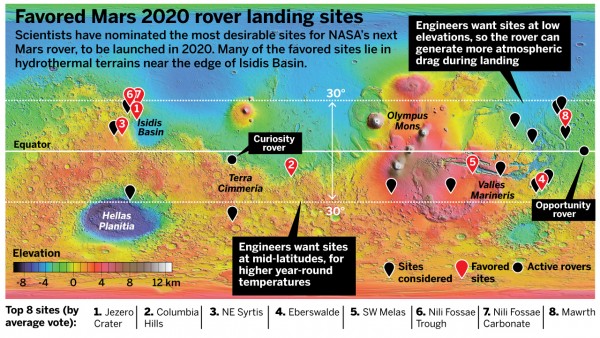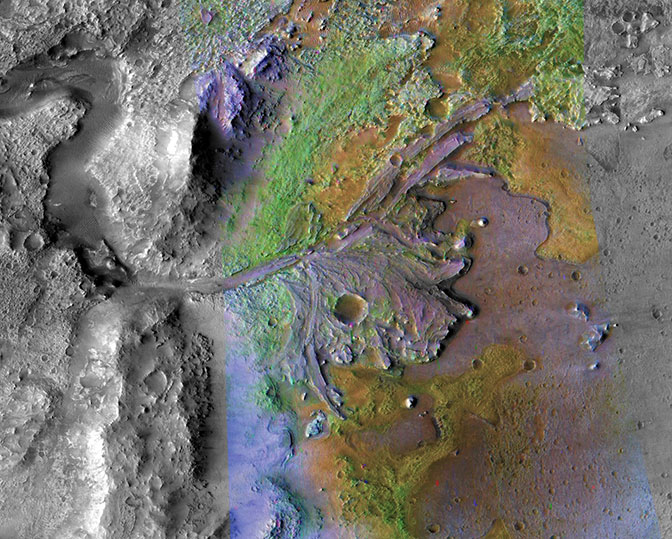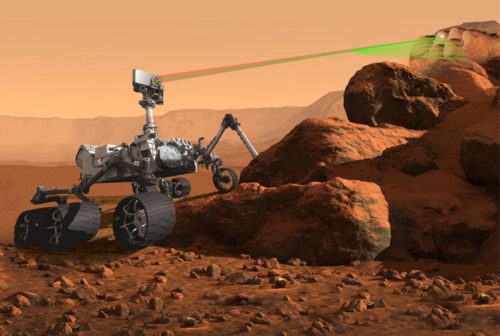
NASA’s next Mars rover is due to launch in July or August 2020, and the number of potential landing sites has now been narrowed down by scientists to eight locations. Out of an initial list of 21 targets, eight sites have been chosen as candidate landing sites for the Mars 2020 Rover. Due to land on Mars in February 2021, the rover will search for rocks which could hold possible evidence of past life on the planet.
The sites were chosen by a vote at the end of a three-day workshop in Monrovia, Calif. The top contenders are locations where there are ancient river deltas and hot springs—ideal places to search for evidence of past microbial life on Mars.
At the top of the list is Jezero crater, where one of the old river deltas is located. “The appeal is twofold,” said Bethany Ehlmann, a planetary scientist at the California Institute of Technology (Caltech) in Pasadena. “Not only is there a delta, but the rocks upstream are varied and diverse.” A river delta is a place where organic material could have been concentrated and preserved in the rocks, just like on Earth. Similarly, the Curiosity rover has found organics in sedimentary rocks in Gale crater, near where ancient streams once emptied into the crater. The Mars 2020 Rover, however, will be better equipped to determine if any organics found have a biological origin or not.

In second place is a location which has already been visited: Columbia Hills in Gusev crater. The Spirit rover previously explored here before it got stuck in a sand trap and died in 2010. Spirit found evidence for past water in the hills, in particular ancient hydrothermal springs, in the form of high amounts of silica. On Earth, at least, hot springs are teeming with microorganisms and other lifeforms. It would be interesting to return there; perhaps the new rover could pay a visit to Spirit as it climbs the hills.
Both river deltas and hydrothermal sites have their advantages but the way organics are preserved are different between the two, and hydrothermal are becoming increasingly important to scientists. According to Ehlmann, “You look in the precipitated veins [of rock], where organisms may have been entombed by mineral formations.”

Other possible sites are near the giant Valles Marineris canyon system (how cool would that be?) and around the edge of Isidis Basin, where there are significant carbonate deposits, which might also help explain how Mars lost its once-thicker atmosphere. According to Ehlmann, the atmosphere “was either lost to space, or it has to be sequestered down in the rock as carbonates. We can explore one of those paths.” And of course, carbonates are just the kind of thing the rover is designed to look for and study.
Design-wise, the Mars 2020 Rover is very similar to the Curiosity rover, but its mission and payload are different. The rover will drill rocks like Curiosity, but this time will collect 30 pencil-sized samples and cache them (after doing its own analysis) for a later mission to return them to Earth. The payload will also be slimmed down, but still have a robust suite of instruments for analyzing samples and studying the terrain. This time, though, the focus is looking for evidence of past biological activity, rather than just searching for organics in general.
The new rover will also land using the “sky crane” system, where it is suspended by cables blowing the descent vehicle and gently lowered to the ground. It was a new and risky procedure for Curiosity, but worked beautifully. For the new rover, engineers are working on improvements which would allow the oval landing ellipse area to shrink by more than 50 percent, to as small as 8 by 4 miles (13 by 7 kilometers). This would help to better target the rover to smaller, interesting areas.
The procedure for collecting the samples has also changed during the design process. Initially, the rock core samples would be placed into a single football-sized container, which would be later retrieved by another lander or rover. Now, however, the samples will be placed into individual sealed metal tubes. These will simply be left on the ground in a “depot.” That way, the rover can return to the depot multiple times to deposit more sample tubes.
“There was no success until we got that package off the rover,” said Ken Farley, the project scientist. “This provides an opportunity to get [the samples] off the rover in a way that’s staged through time. The metal tubes will have to be coated to protect the samples inside from heat for a decade or more.”

The rover will be searching for two primary kinds of samples: rocks which would be suited for preserving organic material and possible biosignatures, and igneous rocks, which will provide more information about Mars’ geological history.
In January 2017, the number of favored sites will be reduced to four, although new sites could still be considered as well. The Mars 2020 Rover mission will be the first since the Viking 1 and 2 landers in the 1970s to specifically search for signs of life, albeit past life in this case. Unless, of course, it got lucky and found some still-living microorganisms, although it isn’t designed to look for those the way Viking was. But it is still a welcome change for those who want new Mars missions to focus more on biology rather than just geology as all of the landers and rovers have done since Viking.
Other photos of the various landing site contenders are here, and more information about the Mars 2020 Rover mission is available here.
Want to keep up-to-date with all things space? Be sure to “Like” AmericaSpace on Facebook and follow us on Twitter: @AmericaSpace




“Jezero” is Serbian for “lake.” That site appears to be a gold mine.
The announced possible sites for the Mars 2020 rover are indeed interesting.
However, I think an important site was left out, Noctis Labyrinthus. Since
the Viking missions it has been known that Noctis frequently displays low
lying fogs or clouds. Since this is a low latitude and low altitude site it
is possible these low lying fogs could contact the ground during the times
the temperatures and pressures are in the range to allow liquid water.
http://www.thelivingmoon.com/43ancients/04images/Mars4/Weather/Clouds_Noctis_Viking_01.gif
http://i.imgur.com/lFvLrgQ.jpg
http://cdn.theatlantic.com/static/mt/assets/science/assets_c/2013/07/Marineris%20fog-thumb-570×738-127871.jpg
Bob Clark
If some one desires expert view regarding running a blog then i advise him/her to go to see this web site, Keep up the good work.|